CADILLAC LYRIC 2023 Owners Manual
Manufacturer: CADILLAC, Model Year: 2023, Model line: LYRIC, Model: CADILLAC LYRIC 2023Pages: 424, PDF Size: 4.76 MB
Page 271 of 424
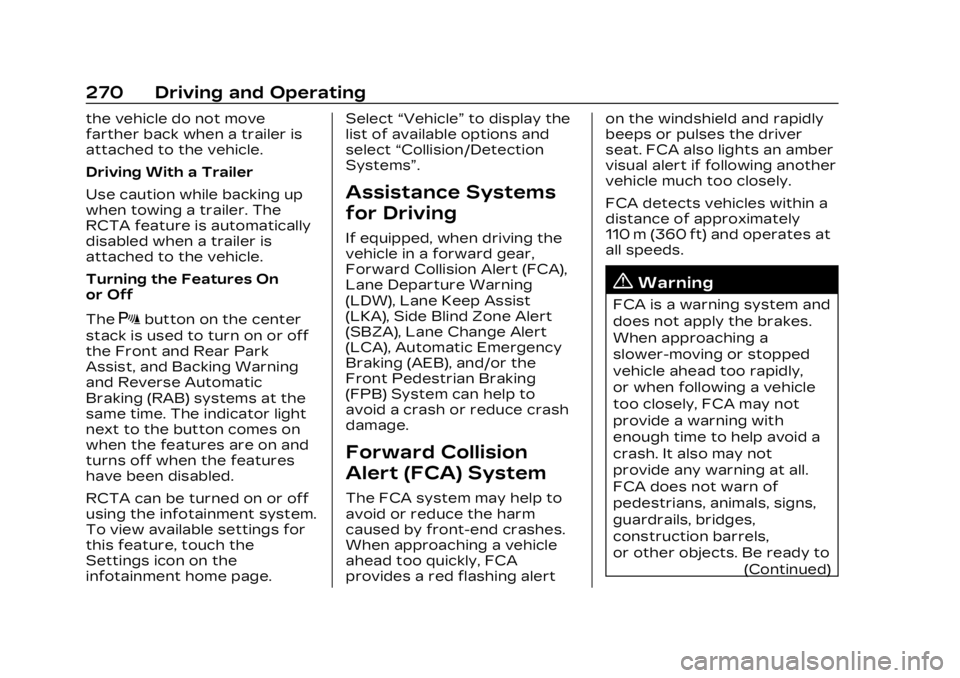
Cadillac Lyriq Owner Manual (GMNA-Localizing-U.S./Canada-15644413) -
2023 - CRC - 2/23/22
270 Driving and Operating
the vehicle do not move
farther back when a trailer is
attached to the vehicle.
Driving With a Trailer
Use caution while backing up
when towing a trailer. The
RCTA feature is automatically
disabled when a trailer is
attached to the vehicle.
Turning the Features On
or Off
The
Xbutton on the center
stack is used to turn on or off
the Front and Rear Park
Assist, and Backing Warning
and Reverse Automatic
Braking (RAB) systems at the
same time. The indicator light
next to the button comes on
when the features are on and
turns off when the features
have been disabled.
RCTA can be turned on or off
using the infotainment system.
To view available settings for
this feature, touch the
Settings icon on the
infotainment home page. Select
“Vehicle” to display the
list of available options and
select “Collision/Detection
Systems”.
Assistance Systems
for Driving
If equipped, when driving the
vehicle in a forward gear,
Forward Collision Alert (FCA),
Lane Departure Warning
(LDW), Lane Keep Assist
(LKA), Side Blind Zone Alert
(SBZA), Lane Change Alert
(LCA), Automatic Emergency
Braking (AEB), and/or the
Front Pedestrian Braking
(FPB) System can help to
avoid a crash or reduce crash
damage.
Forward Collision
Alert (FCA) System
The FCA system may help to
avoid or reduce the harm
caused by front-end crashes.
When approaching a vehicle
ahead too quickly, FCA
provides a red flashing alert on the windshield and rapidly
beeps or pulses the driver
seat. FCA also lights an amber
visual alert if following another
vehicle much too closely.
FCA detects vehicles within a
distance of approximately
110 m (360 ft) and operates at
all speeds.
{Warning
FCA is a warning system and
does not apply the brakes.
When approaching a
slower-moving or stopped
vehicle ahead too rapidly,
or when following a vehicle
too closely, FCA may not
provide a warning with
enough time to help avoid a
crash. It also may not
provide any warning at all.
FCA does not warn of
pedestrians, animals, signs,
guardrails, bridges,
construction barrels,
or other objects. Be ready to
(Continued)
Page 272 of 424
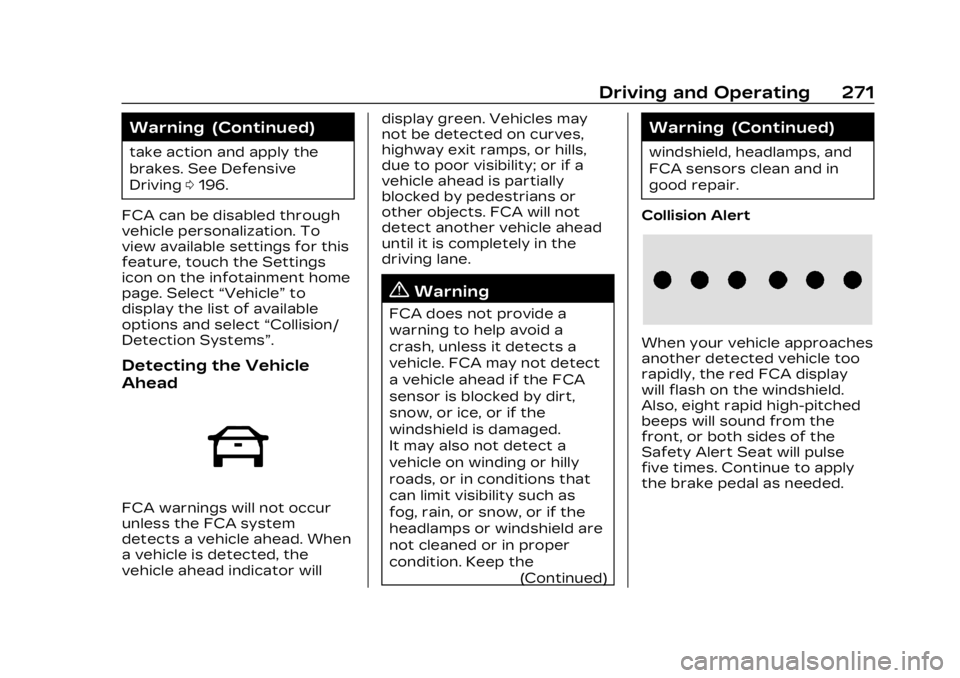
Cadillac Lyriq Owner Manual (GMNA-Localizing-U.S./Canada-15644413) -
2023 - CRC - 2/23/22
Driving and Operating 271
Warning (Continued)
take action and apply the
brakes. See Defensive
Driving0196.
FCA can be disabled through
vehicle personalization. To
view available settings for this
feature, touch the Settings
icon on the infotainment home
page. Select “Vehicle”to
display the list of available
options and select “Collision/
Detection Systems”.
Detecting the Vehicle
Ahead
FCA warnings will not occur
unless the FCA system
detects a vehicle ahead. When
a vehicle is detected, the
vehicle ahead indicator will display green. Vehicles may
not be detected on curves,
highway exit ramps, or hills,
due to poor visibility; or if a
vehicle ahead is partially
blocked by pedestrians or
other objects. FCA will not
detect another vehicle ahead
until it is completely in the
driving lane.
{Warning
FCA does not provide a
warning to help avoid a
crash, unless it detects a
vehicle. FCA may not detect
a vehicle ahead if the FCA
sensor is blocked by dirt,
snow, or ice, or if the
windshield is damaged.
It may also not detect a
vehicle on winding or hilly
roads, or in conditions that
can limit visibility such as
fog, rain, or snow, or if the
headlamps or windshield are
not cleaned or in proper
condition. Keep the
(Continued)
Warning (Continued)
windshield, headlamps, and
FCA sensors clean and in
good repair.
Collision Alert
When your vehicle approaches
another detected vehicle too
rapidly, the red FCA display
will flash on the windshield.
Also, eight rapid high-pitched
beeps will sound from the
front, or both sides of the
Safety Alert Seat will pulse
five times. Continue to apply
the brake pedal as needed.
Page 273 of 424
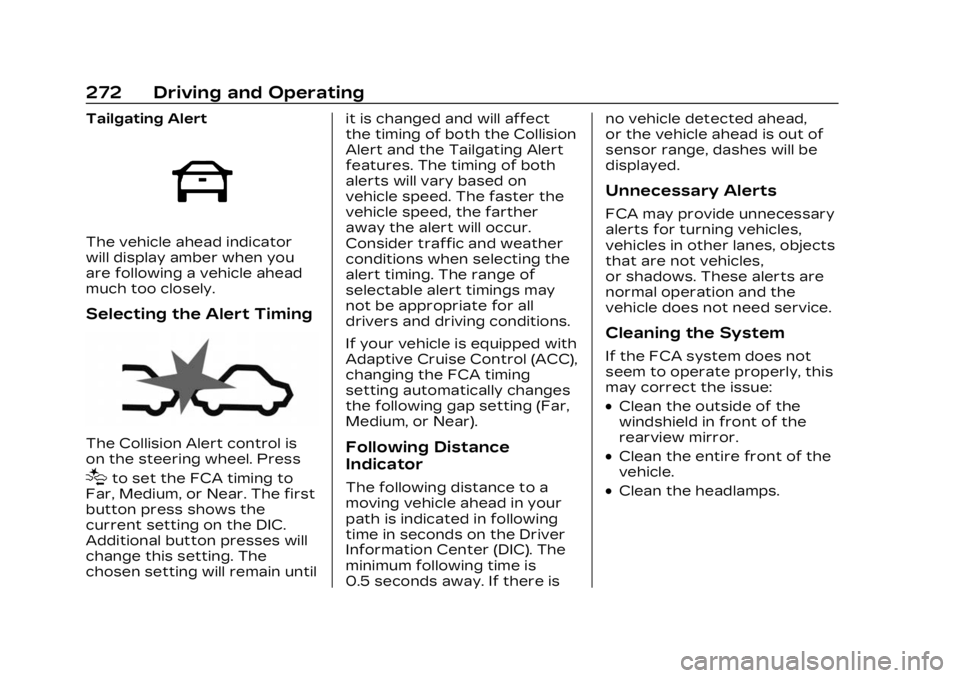
Cadillac Lyriq Owner Manual (GMNA-Localizing-U.S./Canada-15644413) -
2023 - CRC - 2/23/22
272 Driving and Operating
Tailgating Alert
The vehicle ahead indicator
will display amber when you
are following a vehicle ahead
much too closely.
Selecting the Alert Timing
The Collision Alert control is
on the steering wheel. Press
[to set the FCA timing to
Far, Medium, or Near. The first
button press shows the
current setting on the DIC.
Additional button presses will
change this setting. The
chosen setting will remain until it is changed and will affect
the timing of both the Collision
Alert and the Tailgating Alert
features. The timing of both
alerts will vary based on
vehicle speed. The faster the
vehicle speed, the farther
away the alert will occur.
Consider traffic and weather
conditions when selecting the
alert timing. The range of
selectable alert timings may
not be appropriate for all
drivers and driving conditions.
If your vehicle is equipped with
Adaptive Cruise Control (ACC),
changing the FCA timing
setting automatically changes
the following gap setting (Far,
Medium, or Near).
Following Distance
Indicator
The following distance to a
moving vehicle ahead in your
path is indicated in following
time in seconds on the Driver
Information Center (DIC). The
minimum following time is
0.5 seconds away. If there isno vehicle detected ahead,
or the vehicle ahead is out of
sensor range, dashes will be
displayed.
Unnecessary Alerts
FCA may provide unnecessary
alerts for turning vehicles,
vehicles in other lanes, objects
that are not vehicles,
or shadows. These alerts are
normal operation and the
vehicle does not need service.
Cleaning the System
If the FCA system does not
seem to operate properly, this
may correct the issue:
.Clean the outside of the
windshield in front of the
rearview mirror.
.Clean the entire front of the
vehicle.
.Clean the headlamps.
Page 274 of 424
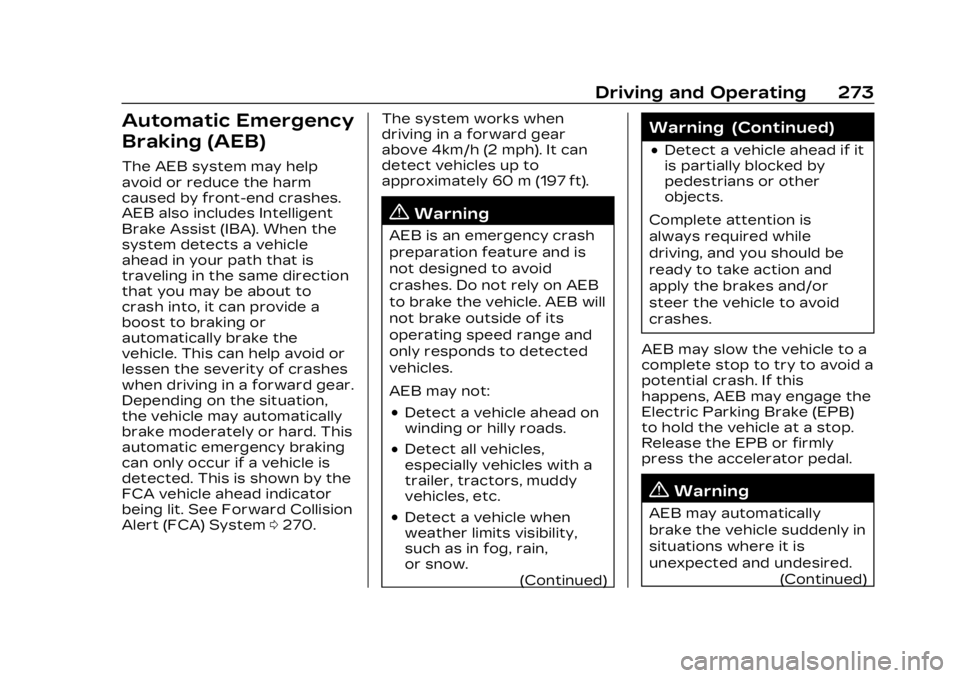
Cadillac Lyriq Owner Manual (GMNA-Localizing-U.S./Canada-15644413) -
2023 - CRC - 2/23/22
Driving and Operating 273
Automatic Emergency
Braking (AEB)
The AEB system may help
avoid or reduce the harm
caused by front-end crashes.
AEB also includes Intelligent
Brake Assist (IBA). When the
system detects a vehicle
ahead in your path that is
traveling in the same direction
that you may be about to
crash into, it can provide a
boost to braking or
automatically brake the
vehicle. This can help avoid or
lessen the severity of crashes
when driving in a forward gear.
Depending on the situation,
the vehicle may automatically
brake moderately or hard. This
automatic emergency braking
can only occur if a vehicle is
detected. This is shown by the
FCA vehicle ahead indicator
being lit. See Forward Collision
Alert (FCA) System0270. The system works when
driving in a forward gear
above 4km/h (2 mph). It can
detect vehicles up to
approximately 60 m (197 ft).
{Warning
AEB is an emergency crash
preparation feature and is
not designed to avoid
crashes. Do not rely on AEB
to brake the vehicle. AEB will
not brake outside of its
operating speed range and
only responds to detected
vehicles.
AEB may not:
.Detect a vehicle ahead on
winding or hilly roads.
.Detect all vehicles,
especially vehicles with a
trailer, tractors, muddy
vehicles, etc.
.Detect a vehicle when
weather limits visibility,
such as in fog, rain,
or snow.
(Continued)
Warning (Continued)
.Detect a vehicle ahead if it
is partially blocked by
pedestrians or other
objects.
Complete attention is
always required while
driving, and you should be
ready to take action and
apply the brakes and/or
steer the vehicle to avoid
crashes.
AEB may slow the vehicle to a
complete stop to try to avoid a
potential crash. If this
happens, AEB may engage the
Electric Parking Brake (EPB)
to hold the vehicle at a stop.
Release the EPB or firmly
press the accelerator pedal.
{Warning
AEB may automatically
brake the vehicle suddenly in
situations where it is
unexpected and undesired. (Continued)
Page 275 of 424
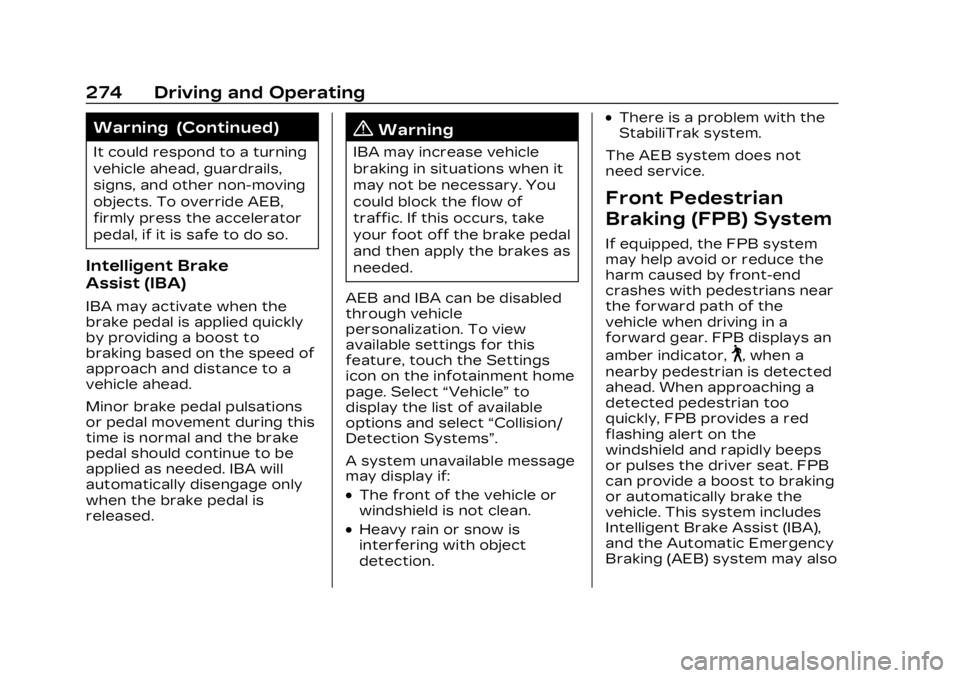
Cadillac Lyriq Owner Manual (GMNA-Localizing-U.S./Canada-15644413) -
2023 - CRC - 2/23/22
274 Driving and Operating
Warning (Continued)
It could respond to a turning
vehicle ahead, guardrails,
signs, and other non-moving
objects. To override AEB,
firmly press the accelerator
pedal, if it is safe to do so.
Intelligent Brake
Assist (IBA)
IBA may activate when the
brake pedal is applied quickly
by providing a boost to
braking based on the speed of
approach and distance to a
vehicle ahead.
Minor brake pedal pulsations
or pedal movement during this
time is normal and the brake
pedal should continue to be
applied as needed. IBA will
automatically disengage only
when the brake pedal is
released.
{Warning
IBA may increase vehicle
braking in situations when it
may not be necessary. You
could block the flow of
traffic. If this occurs, take
your foot off the brake pedal
and then apply the brakes as
needed.
AEB and IBA can be disabled
through vehicle
personalization. To view
available settings for this
feature, touch the Settings
icon on the infotainment home
page. Select “Vehicle”to
display the list of available
options and select “Collision/
Detection Systems”.
A system unavailable message
may display if:
.The front of the vehicle or
windshield is not clean.
.Heavy rain or snow is
interfering with object
detection.
.There is a problem with the
StabiliTrak system.
The AEB system does not
need service.
Front Pedestrian
Braking (FPB) System
If equipped, the FPB system
may help avoid or reduce the
harm caused by front-end
crashes with pedestrians near
the forward path of the
vehicle when driving in a
forward gear. FPB displays an
amber indicator,
~, when a
nearby pedestrian is detected
ahead. When approaching a
detected pedestrian too
quickly, FPB provides a red
flashing alert on the
windshield and rapidly beeps
or pulses the driver seat. FPB
can provide a boost to braking
or automatically brake the
vehicle. This system includes
Intelligent Brake Assist (IBA),
and the Automatic Emergency
Braking (AEB) system may also
Page 276 of 424
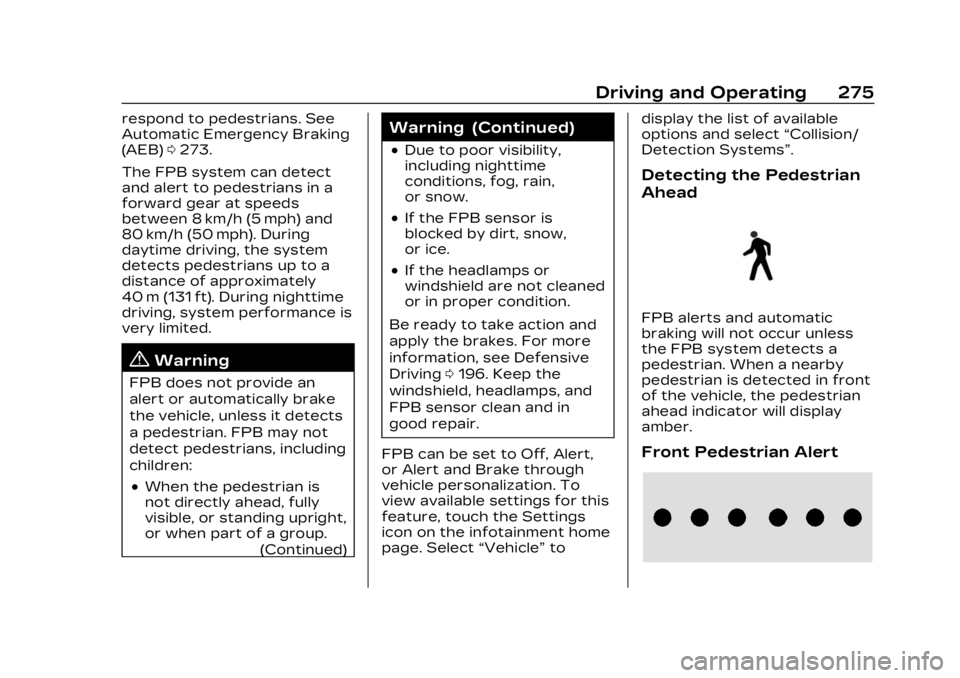
Cadillac Lyriq Owner Manual (GMNA-Localizing-U.S./Canada-15644413) -
2023 - CRC - 2/23/22
Driving and Operating 275
respond to pedestrians. See
Automatic Emergency Braking
(AEB)0273.
The FPB system can detect
and alert to pedestrians in a
forward gear at speeds
between 8 km/h (5 mph) and
80 km/h (50 mph). During
daytime driving, the system
detects pedestrians up to a
distance of approximately
40 m (131 ft). During nighttime
driving, system performance is
very limited.
{Warning
FPB does not provide an
alert or automatically brake
the vehicle, unless it detects
a pedestrian. FPB may not
detect pedestrians, including
children:
.When the pedestrian is
not directly ahead, fully
visible, or standing upright,
or when part of a group. (Continued)
Warning (Continued)
.Due to poor visibility,
including nighttime
conditions, fog, rain,
or snow.
.If the FPB sensor is
blocked by dirt, snow,
or ice.
.If the headlamps or
windshield are not cleaned
or in proper condition.
Be ready to take action and
apply the brakes. For more
information, see Defensive
Driving 0196. Keep the
windshield, headlamps, and
FPB sensor clean and in
good repair.
FPB can be set to Off, Alert,
or Alert and Brake through
vehicle personalization. To
view available settings for this
feature, touch the Settings
icon on the infotainment home
page. Select “Vehicle”to display the list of available
options and select
“Collision/
Detection Systems”.
Detecting the Pedestrian
Ahead
FPB alerts and automatic
braking will not occur unless
the FPB system detects a
pedestrian. When a nearby
pedestrian is detected in front
of the vehicle, the pedestrian
ahead indicator will display
amber.
Front Pedestrian Alert
Page 277 of 424
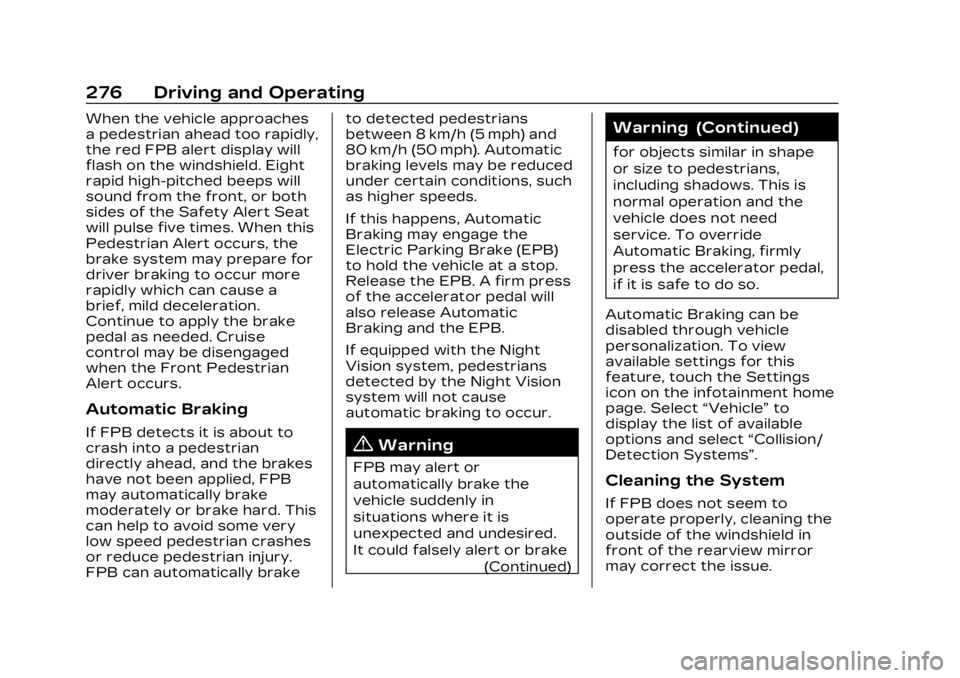
Cadillac Lyriq Owner Manual (GMNA-Localizing-U.S./Canada-15644413) -
2023 - CRC - 2/23/22
276 Driving and Operating
When the vehicle approaches
a pedestrian ahead too rapidly,
the red FPB alert display will
flash on the windshield. Eight
rapid high-pitched beeps will
sound from the front, or both
sides of the Safety Alert Seat
will pulse five times. When this
Pedestrian Alert occurs, the
brake system may prepare for
driver braking to occur more
rapidly which can cause a
brief, mild deceleration.
Continue to apply the brake
pedal as needed. Cruise
control may be disengaged
when the Front Pedestrian
Alert occurs.
Automatic Braking
If FPB detects it is about to
crash into a pedestrian
directly ahead, and the brakes
have not been applied, FPB
may automatically brake
moderately or brake hard. This
can help to avoid some very
low speed pedestrian crashes
or reduce pedestrian injury.
FPB can automatically braketo detected pedestrians
between 8 km/h (5 mph) and
80 km/h (50 mph). Automatic
braking levels may be reduced
under certain conditions, such
as higher speeds.
If this happens, Automatic
Braking may engage the
Electric Parking Brake (EPB)
to hold the vehicle at a stop.
Release the EPB. A firm press
of the accelerator pedal will
also release Automatic
Braking and the EPB.
If equipped with the Night
Vision system, pedestrians
detected by the Night Vision
system will not cause
automatic braking to occur.{Warning
FPB may alert or
automatically brake the
vehicle suddenly in
situations where it is
unexpected and undesired.
It could falsely alert or brake
(Continued)
Warning (Continued)
for objects similar in shape
or size to pedestrians,
including shadows. This is
normal operation and the
vehicle does not need
service. To override
Automatic Braking, firmly
press the accelerator pedal,
if it is safe to do so.
Automatic Braking can be
disabled through vehicle
personalization. To view
available settings for this
feature, touch the Settings
icon on the infotainment home
page. Select “Vehicle”to
display the list of available
options and select “Collision/
Detection Systems”.
Cleaning the System
If FPB does not seem to
operate properly, cleaning the
outside of the windshield in
front of the rearview mirror
may correct the issue.
Page 278 of 424
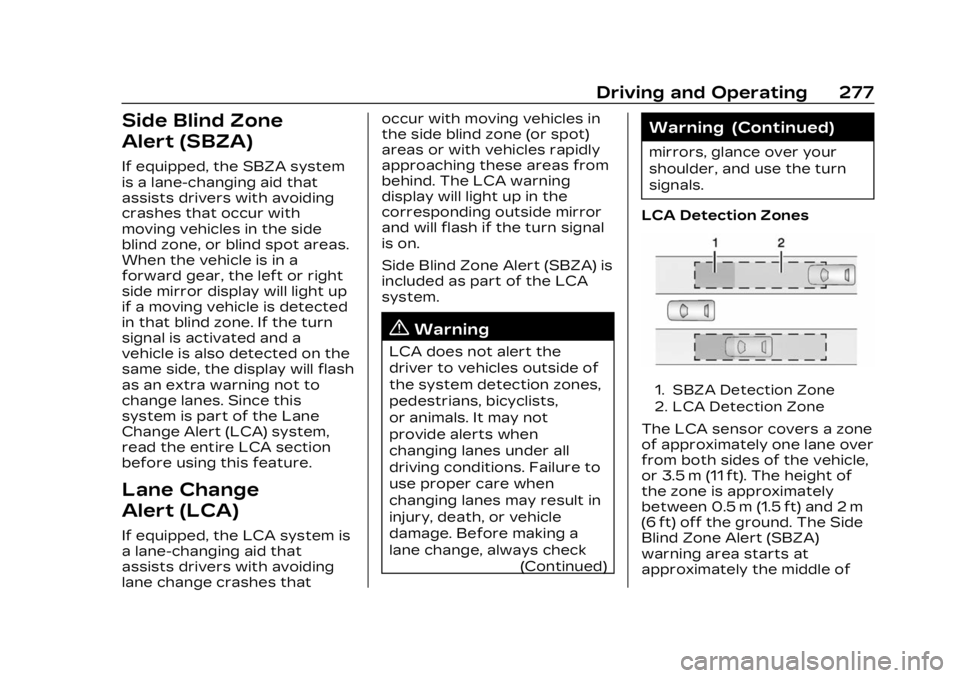
Cadillac Lyriq Owner Manual (GMNA-Localizing-U.S./Canada-15644413) -
2023 - CRC - 2/23/22
Driving and Operating 277
Side Blind Zone
Alert (SBZA)
If equipped, the SBZA system
is a lane-changing aid that
assists drivers with avoiding
crashes that occur with
moving vehicles in the side
blind zone, or blind spot areas.
When the vehicle is in a
forward gear, the left or right
side mirror display will light up
if a moving vehicle is detected
in that blind zone. If the turn
signal is activated and a
vehicle is also detected on the
same side, the display will flash
as an extra warning not to
change lanes. Since this
system is part of the Lane
Change Alert (LCA) system,
read the entire LCA section
before using this feature.
Lane Change
Alert (LCA)
If equipped, the LCA system is
a lane-changing aid that
assists drivers with avoiding
lane change crashes thatoccur with moving vehicles in
the side blind zone (or spot)
areas or with vehicles rapidly
approaching these areas from
behind. The LCA warning
display will light up in the
corresponding outside mirror
and will flash if the turn signal
is on.
Side Blind Zone Alert (SBZA) is
included as part of the LCA
system.
{Warning
LCA does not alert the
driver to vehicles outside of
the system detection zones,
pedestrians, bicyclists,
or animals. It may not
provide alerts when
changing lanes under all
driving conditions. Failure to
use proper care when
changing lanes may result in
injury, death, or vehicle
damage. Before making a
lane change, always check
(Continued)
Warning (Continued)
mirrors, glance over your
shoulder, and use the turn
signals.
LCA Detection Zones
1. SBZA Detection Zone
2. LCA Detection Zone
The LCA sensor covers a zone
of approximately one lane over
from both sides of the vehicle,
or 3.5 m (11 ft). The height of
the zone is approximately
between 0.5 m (1.5 ft) and 2 m
(6 ft) off the ground. The Side
Blind Zone Alert (SBZA)
warning area starts at
approximately the middle of
Page 279 of 424
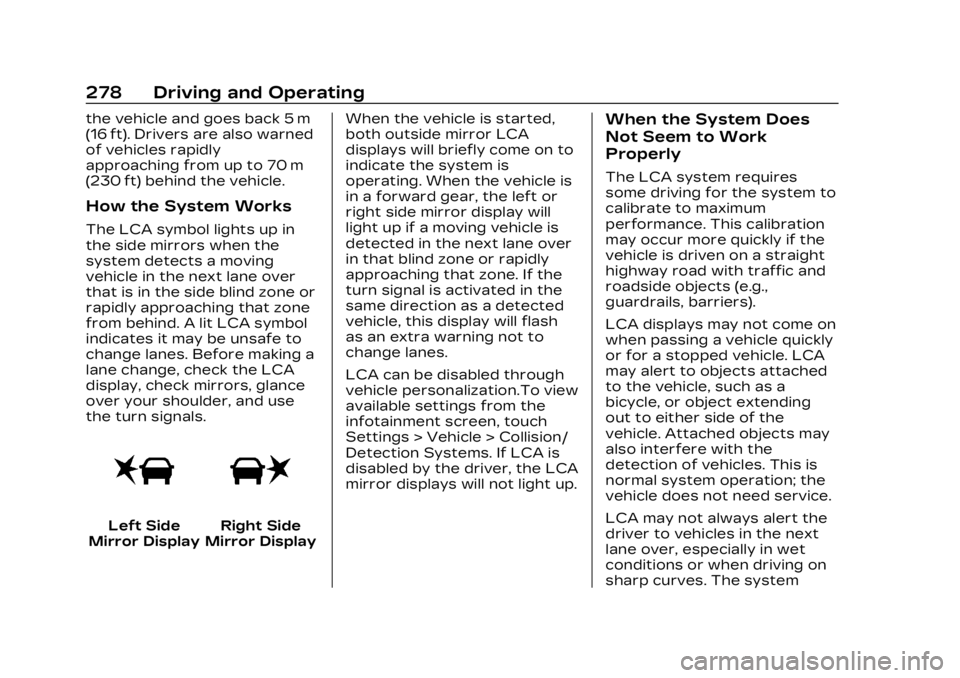
Cadillac Lyriq Owner Manual (GMNA-Localizing-U.S./Canada-15644413) -
2023 - CRC - 2/23/22
278 Driving and Operating
the vehicle and goes back 5 m
(16 ft). Drivers are also warned
of vehicles rapidly
approaching from up to 70 m
(230 ft) behind the vehicle.
How the System Works
The LCA symbol lights up in
the side mirrors when the
system detects a moving
vehicle in the next lane over
that is in the side blind zone or
rapidly approaching that zone
from behind. A lit LCA symbol
indicates it may be unsafe to
change lanes. Before making a
lane change, check the LCA
display, check mirrors, glance
over your shoulder, and use
the turn signals.
Left Side
Mirror DisplayRight Side
Mirror Display When the vehicle is started,
both outside mirror LCA
displays will briefly come on to
indicate the system is
operating. When the vehicle is
in a forward gear, the left or
right side mirror display will
light up if a moving vehicle is
detected in the next lane over
in that blind zone or rapidly
approaching that zone. If the
turn signal is activated in the
same direction as a detected
vehicle, this display will flash
as an extra warning not to
change lanes.
LCA can be disabled through
vehicle personalization.To view
available settings from the
infotainment screen, touch
Settings > Vehicle > Collision/
Detection Systems. If LCA is
disabled by the driver, the LCA
mirror displays will not light up.
When the System Does
Not Seem to Work
Properly
The LCA system requires
some driving for the system to
calibrate to maximum
performance. This calibration
may occur more quickly if the
vehicle is driven on a straight
highway road with traffic and
roadside objects (e.g.,
guardrails, barriers).
LCA displays may not come on
when passing a vehicle quickly
or for a stopped vehicle. LCA
may alert to objects attached
to the vehicle, such as a
bicycle, or object extending
out to either side of the
vehicle. Attached objects may
also interfere with the
detection of vehicles. This is
normal system operation; the
vehicle does not need service.
LCA may not always alert the
driver to vehicles in the next
lane over, especially in wet
conditions or when driving on
sharp curves. The system
Page 280 of 424
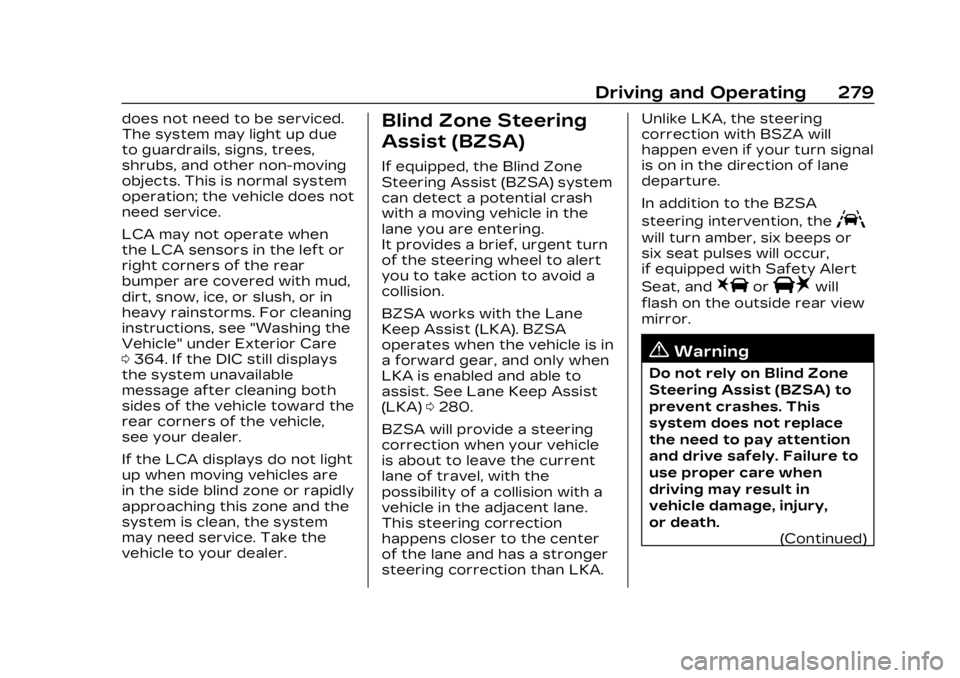
Cadillac Lyriq Owner Manual (GMNA-Localizing-U.S./Canada-15644413) -
2023 - CRC - 2/23/22
Driving and Operating 279
does not need to be serviced.
The system may light up due
to guardrails, signs, trees,
shrubs, and other non-moving
objects. This is normal system
operation; the vehicle does not
need service.
LCA may not operate when
the LCA sensors in the left or
right corners of the rear
bumper are covered with mud,
dirt, snow, ice, or slush, or in
heavy rainstorms. For cleaning
instructions, see "Washing the
Vehicle" under Exterior Care
0364. If the DIC still displays
the system unavailable
message after cleaning both
sides of the vehicle toward the
rear corners of the vehicle,
see your dealer.
If the LCA displays do not light
up when moving vehicles are
in the side blind zone or rapidly
approaching this zone and the
system is clean, the system
may need service. Take the
vehicle to your dealer.Blind Zone Steering
Assist (BZSA)
If equipped, the Blind Zone
Steering Assist (BZSA) system
can detect a potential crash
with a moving vehicle in the
lane you are entering.
It provides a brief, urgent turn
of the steering wheel to alert
you to take action to avoid a
collision.
BZSA works with the Lane
Keep Assist (LKA). BZSA
operates when the vehicle is in
a forward gear, and only when
LKA is enabled and able to
assist. See Lane Keep Assist
(LKA) 0280.
BZSA will provide a steering
correction when your vehicle
is about to leave the current
lane of travel, with the
possibility of a collision with a
vehicle in the adjacent lane.
This steering correction
happens closer to the center
of the lane and has a stronger
steering correction than LKA. Unlike LKA, the steering
correction with BSZA will
happen even if your turn signal
is on in the direction of lane
departure.
In addition to the BZSA
steering intervention, the
A
will turn amber, six beeps or
six seat pulses will occur,
if equipped with Safety Alert
Seat, and
8or|will
flash on the outside rear view
mirror.
{Warning
Do not rely on Blind Zone
Steering Assist (BZSA) to
prevent crashes. This
system does not replace
the need to pay attention
and drive safely. Failure to
use proper care when
driving may result in
vehicle damage, injury,
or death.
(Continued)